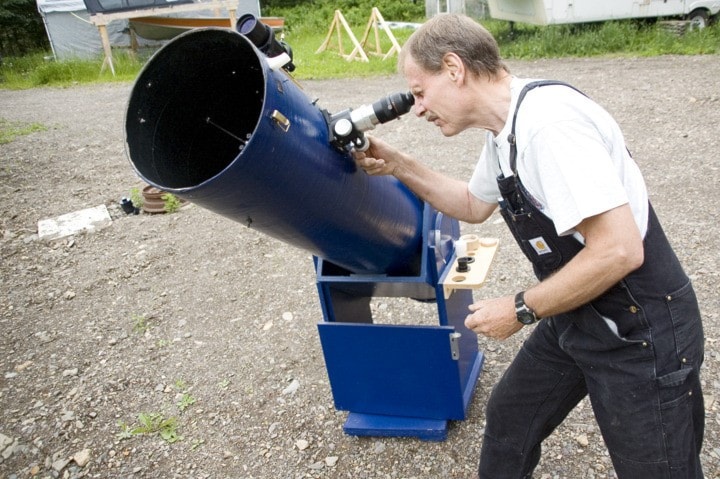At first glance, Harm Dekker's yard looks full of ordinary, earthbound stuff—a boat, a workshop and, in the midst of it all, a garden shed.
"Nothing fancy," he says.
But if you know about Dekker's stellar hobby, things start to catch your eye.
Propping up his bird feeder, for instance, is a hand-made wooden tripod, now retired, that can still swivel to any point in the sky.
And inside his workshop, tucked behind a ride-on mower he's fixing for a neighbour, Dekker has a D.I.Y. tool that has traced the skies for 10 years now—a 1.5-metre Dobsonian telescope built from a concrete forming tube and a hand-ground mirror.
"It's not that spectacular," Dekker says, peering down at a spider that's fallen on the telescope's 12.5-inch mirror.
It's not the Hubble, he says.
"But if I can look at the Andromeda galaxy, which is 2.5 million light years away, I think, 'This is pretty good.'"
Growing up in Holland, Dekker remembers his mom pointing out the Big Bear, or Big Dipper, and a few other constellations.
He was curious, he says, but not especially so. In school he focused on things much closer to hand—machining and fixing cars.
And then, twelve years ago in Houston, he had a look through a friend's telescope at Mars.
Look at Mars on the right night, Dekker says, and you can watch dust storms blur and clear again, revealing its polar caps.
Look at Jupiter, he says, and you can sometimes see the shadow of Lo, one of its 66 moons, casting a shadow on the planet's surface.
When most people think telescopes, they think of the refracting kind—the type built by Galileo to focus a magnified image on the eye.
Such telescopes are best for enlarging what we can already see with our naked eyes—the moon, the planets, and the stars of our own Milky Way galaxy.
But a reflecting telescope like the Dobsonian is a different breed, Dekker explains.

Sometimes called "light buckets," such big-mirror telescopes are designed to capture enough light that they not only reflect bright stars and planets but also deep-sky objects—galaxies, nebulae and star clouds.
"One time the transparency was just awesome, and I looked at the Virgo galaxy cluster," Dekker said, referring to a cluster some 65 million light years away.
"I had seven galaxies in my eyepiece. I couldn't believe it—seven!"
Along with power, Dobsonians are known for being a lot of fun to use.
Their inventor, John Dobson, called them "sidewalk telescopes." He built them from cheap materials—plywood and ship's porthole glass—and made them light enough that he set them down on random San Francisco streets and give random passerby a free viewing.
Dekker's own Dobsonian swivels on six Teflon pads added little to the $1,200 he paid for its mirror and lenses, and the whole thing spins on the base of an old record player.
"Oh yeah," he said, smiling. "It runs so smooth."

Like his 4-inch refractor, Dekker says his Dobsonian could be motorized so that it automatically tracks an object, such as Saturn, as it rises and sets across the sky.
But it's more fun to leave it as is, he says.
With help from friend and fellow backyard astronomer Sherman Williams, Dekker recently spent a night scoping out 18 deep-sky objects that Williams found and pin-pointed with a bright green laser.
"He knows all his constellations, so he goes from star to star—we call that 'star hopping,'" Dekker says.
"Using this, you really learn the sky."
A Dobsonian is a great way to start, Dekker says, and can easily be fit with NASA-grade solar filters to pick out sunspots as well as stars.
But after 10 years with the big blue telescope, Dekker took his astronomy a big step up.
Around the back of Dekker's "shed" is a strange addition—a pair of waist-high rails stretch some 20 feet behind it.
Unbolting the shed's plywood door, Dekker steps into the 10 by 10-foot building and knocks out a few wooden dowels.
He opens a window on the far side, and it's clear there's another telescope inside—this one a top-of-the-line Cassegrain with a 14-inch mirror that Dekker can hook up to digital cameras and control from inside his house.
He shoves the shed wall and the entire roof rolls loudly away.
"Now here's the sky!" he says.

Dekker says people often ask why he didn't buy a classic roof for his observatory—a spinning dome with a curved and sliding window.
"I have to watch the snow," he says, noting the peaked tin on his rolling roof.
And it's just not his style, he adds—a simple set-up that works wonders.
"I roll off and pick up Polaris just like that."
Dekker invites anyone keen on star-gazing in Houston to give him a call.
Mid-summer means a pretty short window of dark sky, he says, but solar flares have been really impressive for the last few weeks.
Whatever telescope you use, he says, you need good conditions—low humidity, low wind, and low light from town.
Lights from the Houston pellet plant were adding a lot of glare a while ago, he said, and just as those improved the Canfor sawmill installed brighter yard lights.
But Dekker says there's likely a cheap solution—aluminum shielding to stop the light going skywards.
He's also hoping to host more school groups, something he did with an elementary school science class a few summers ago.
"I'd love to show children around because that's our next generation.
"The moon—that totally blows them away," he adds, sounding mighty impressed himself.

A photo of a nine-day moon taken by Dekker shows craters and mountain ranges on the lunar surface.
